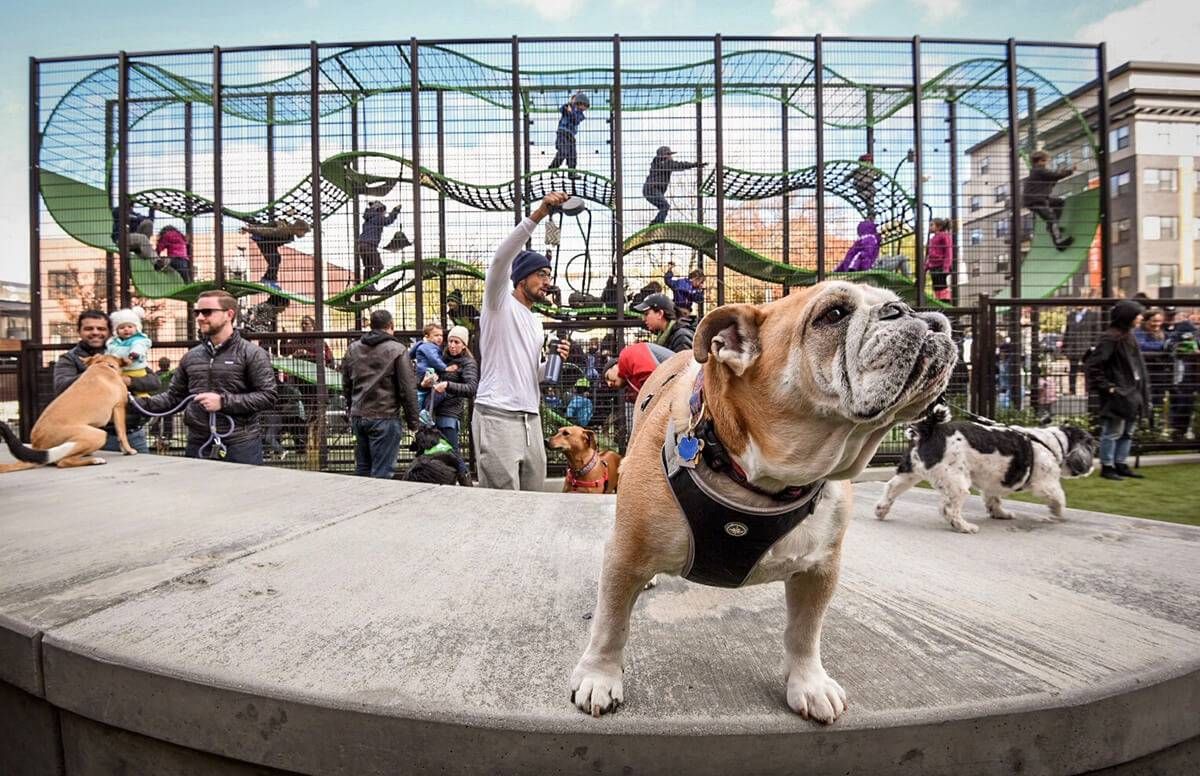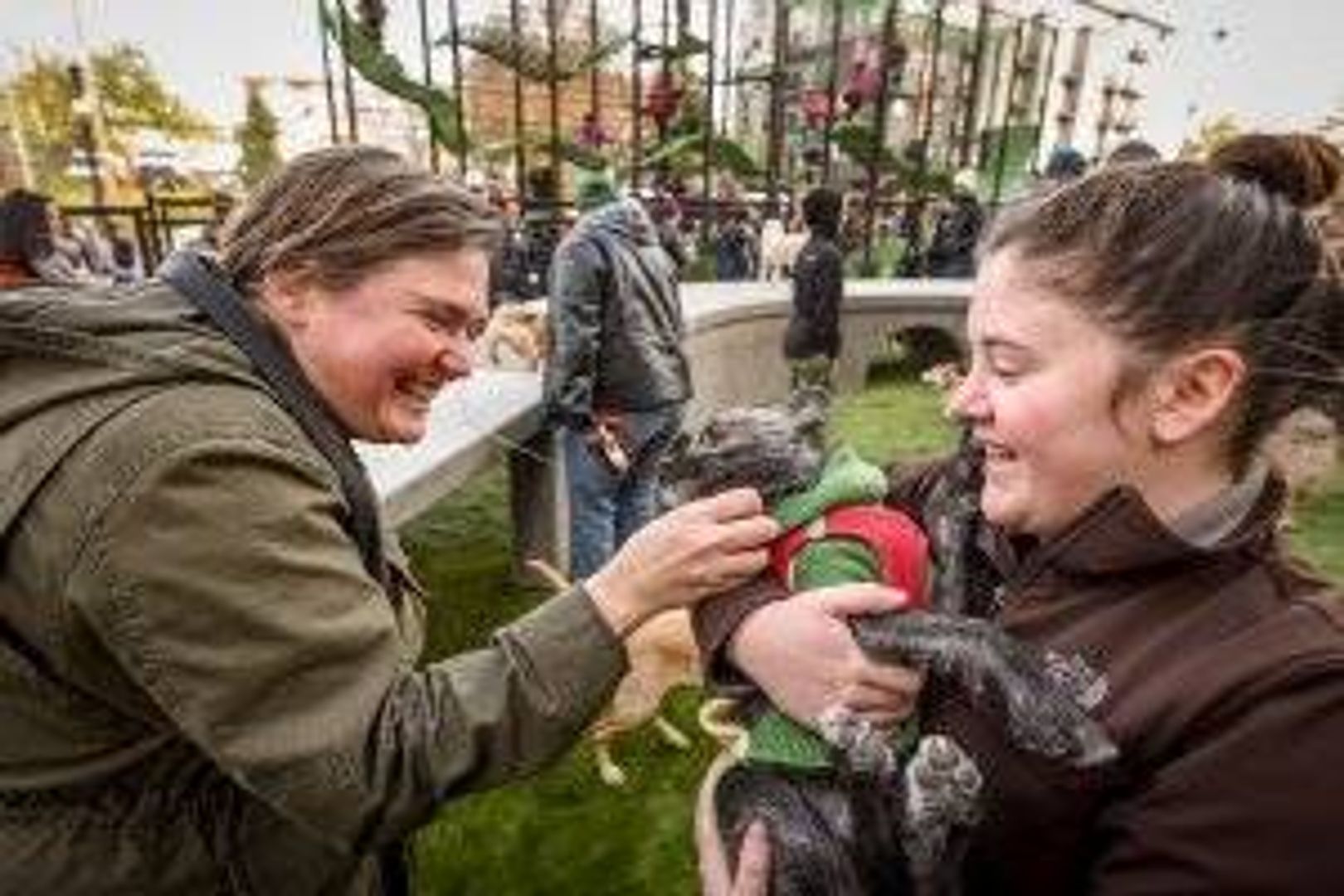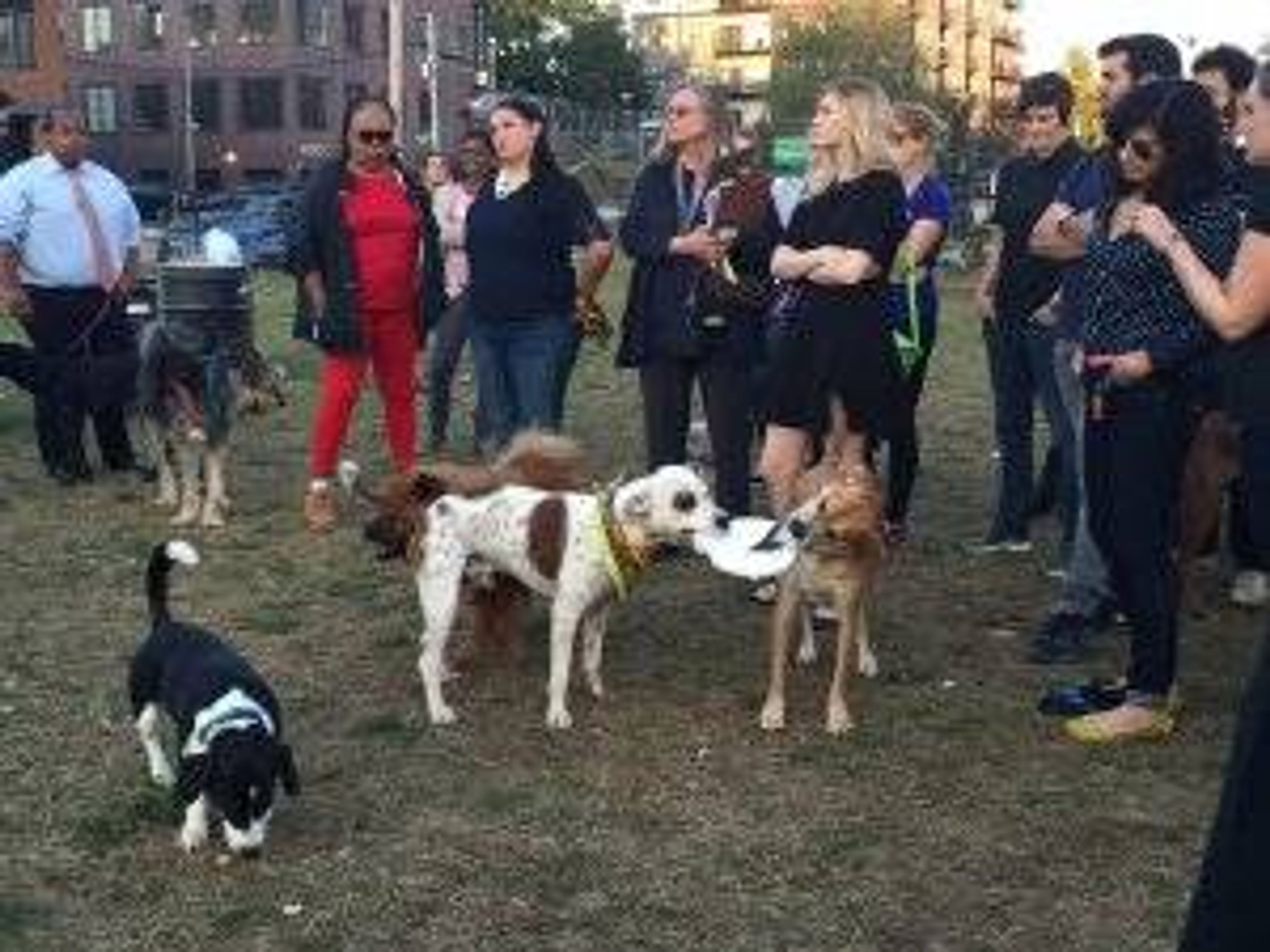The Joys of My Hipster Dog Park
A former rundown space became a vibrant addition to an urban D.C. neighborhood
I was new to a transitioning Washington, D.C. neighborhood when I adopted two rescue puppies in 2015; Tennessee Williams and Hudson River are their formal names. They found a home with me in my urban oasis, a quiet enclave in the District, lined with row houses. And together, we dove into our new community, paws first.

The area was once called Swampoodle — a reminder of the days, in the late 1800s, of a swampy D.C. when the Tiber Creek, now long dried out and buried, used to flood, leaving puddles in its wake.
The neighborhood is now Greater NoMa (North of Massachusetts Avenue) and Swampoodle is the name of our first, and currently, only community park — one part kid park, one part dog park and one part community gathering space. It took more than three years to get that little park, all 8,000 square feet of it, to become a reality.

Swampoodle Park, which was made possible by the NoMa Parks Foundation, an arm of the NoMa BID (Business Improvement District), is part of a vibrant transformation taking place in a neighborhood that spent more than five decades in turmoil after the 1968 assassination of Rev. Martin Luther King, Jr. The changes taking place here are punctuated by the neighborhood's commitment to embracing diversity.
We lobbied for our cause, showing up at every community meeting armed with facts to combat the small, but vocal opposition to a neighborhood dog park.
I'm a bit of an anomaly in my neighborhood — a 53-year old, divorced white woman, born and raised in Manhattan. I live in a world of transplanted millennials, hipsters with young children, aging African-Americans and, with Gallaudet University as a neighbor, a large deaf and hearing-impaired population.
The divisions are physical, too. Above-ground tracks run right through the center of NoMa, bringing in Amtrak and Metro, as well as regional rail. The west side of the tracks looks like Midtown Manhattan with its crisp, new high rises along with NPR, CNN and myriad federal offices. The east side of the tracks has a Brooklyn feel, with colorful row houses dating back to the turn of the century.
Building a Community
2015 was the beginning of the era I affectionately dubbed "The Sandlot Days." That's when seemingly overnight, a locked, fully fenced 60,000-square-feet-plus eyesore of a lot, was miraculously unlocked.
Officially, it was nothing but a plot of land, riddled with city detritus, more dirt than grass or weeds. We were hungry for community and we made it into a gathering space. Hundreds of us "entered at our own risk," vigilantes in it together. We were from all over, even the dogs (including one from Kazakhstan) — with varied geographic histories, backgrounds, educations, ages, races and religions.
But our differences made no difference.
We poured in from each side of the tracks, before work and in the middle of the day, and especially after work — even after dark, during the short, cold days of winter. There were no lights, yet there was an endless stream of people and dogs.
"We all knew we were breaking the law, but we also knew we were desperate for some green space for ourselves and our dogs," says Salim Bhabhrawala, 43, who had lived in NoMa for 12 years before the great unlocking event of 2015.
"My dog Watson and I snuck in there at least twice a week. [Then], week by week, more and more dogs joined in, and organically over time, we had a community … It became 'a thing.' [I] forged lifelong human and canine friends in that old chunk of land," says Bhabhrawala, who is from East Lansing, Mich. He referred to the park community as the "Great NoMa Canine Rebellion."

"I used to call [it] the 'guerrilla park,'" says Lindsay Zoeller, 36. From Louisville, Ky., Zoeller says she and her husband used their five-year-old dog, Penny, as "our excuse to go and hang out with people, meet our neighbors, socialize. Everyone was there, even people who didn't have dogs would go just to hang out."
It was a "melting pot as far as demographics," recalls DeVonne Mosby, 57, a twice-daily visitor with his Rottweiler puppy, Axel, now four. Mosby has since sold his row house and moved to nearby Riverdale, Md. We became friends because our dogs became friends.
"In the beginning, the sole purpose was to get the dog out for a little exercise," recalls Mosby. "But it eventually became a social outlet for [me]," says the Pittsburgh native who had lived in Greater NoMa, dog-free, for 13 years.
In the warmer months, people would come to the sandlot with dogs in tow, pulling coolers filled with beer and wagons filled with wine, to share with anyone who wanted to join in. We used old, abandoned and rusting barrels as a makeshift bar. And while our dogs romped, the humans connected.
Recent college grads could be seen chatting it up with Washington Post columnists; older residents raised in the neighborhood could be found debating politics with Capitol Hill staffers. There were engagements and weddings celebrated, babies born, new puppies adopted.
"There was a feeling of togetherness with the lot," says Mosby.
'It Was the Start of Something'
We all knew, however, that we were living on borrowed time, that the field was now worth millions and ripe for development.
"So maybe that's what drove us to become a tighter knit group," says Mosby.
Fearing the inevitable, we worried about where our dogs would play in the future. The closest dog park was 35 minutes away on foot. "Everyone was committed to 'going down with the ship' and maybe hoping for a miracle," says Mosby.
We organized park clean-ups to show whomever might be watching that we were dedicated to bettering our community. We moved abandoned poop-bag stands into the sandlot and covered fence holes with chicken wire. And, as our dogs roamed the dirt field — a patchwork of thick, messy puddles in the spring, or frozen skating rinks in the winter — we worked informally on a plan for a real dog park.
"I didn't want to lose that sense of connection with my neighbors, neighborhood and community," says Zoeller. "D.C. is such a transient city, it's easy to live here and never know anyone … to live here and not be a part of the city."
I introduced myself to hundreds of people, collecting human and dog names which I typed into my phone. Another dog mom, a 60-something with a schnauzer named Mickey, brought pens and clipboards lined with paper for people to jot down their names. In less than a month, we collected a list that overflowed with the names of more than 450 dogs who used the park at least once a week.
A 40-something lobbyist for NBC Universal with a cockapoo named Charlie posted an online petition for a park and we invited our city councilman to hear about the community we had built, to listen to what we wanted.
"The moment that Councilman Allen stood [before more than 100 of] us on that lot in October 2015 and acknowledged that he would address our needs, we knew we had succeeded," says Bhabhrawala. "It was the start of something."
We lobbied for our cause, showing up at every community meeting armed with facts to combat the small, but vocal opposition to a neighborhood dog park. That only made us work harder.
Building a Real Park
At the time, dog parks were fast becoming the hottest thing in city parks. According to an April 2015 report, "2015 City Park Facts," published by the Trust for Public Land, the number of off-leash dog parks increased 20% between 2010 and 2015. Other reports documented the benefits to dogs, that "dog parks make for better dogs." According to the American Kennel Club (AKC), "Well-exercised dogs are better neighbors who are less likely to create a nuisance, bark excessively, and destroy property."
Even more powerful was the AKC's research that showed exactly what we'd found at the sandlot: "The love people share for their dogs reaches beyond economic and social barriers and helps foster a sense of community."
And that's why I did it. For community.
And that's why, a year after going to the park twice a day, when the people with hardhats started lurking, and eventually a new lock barred the gates, and my dogs looked at me, waiting for me pull open the latch and let them in so they could play with their friends — that's why I pushed even harder for a community park.
"Apparently, we were relentless," says Zoeller who, nearly four years later, in our new park, which opened in November 2018, loves to listen in on conversations about the "sandlot days."
Zoeller calls it the "bougiest dog park in the city," and it kind of is, with its underground sprinklers and automatic gate locks, a dog-play structure and no mud puddles to speak of.
It's not the sandlot, but it's a community park that continues to bring our diverse community together.

